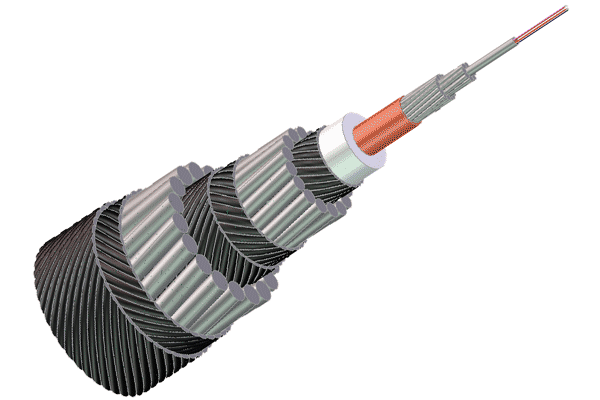Design
Modern Fibre optic cables can carry many millions of telephone calls, together with huge amounts of video and internet data. Approximately 95% of the world’s telecommunication requirements are met by submarine cables. Cables are used because of their high reliability, capacity and security. Cables have an insignificant delay compared to satellite and are most cost-effective on major routes, hence communications costs are cheaper than satellites.
Since the inception of fibre optic cables in the late 1980’s, it is likely that in excess of 1 million kilometers of cable has been laid. The longest cable system; Sea-Me-We 4 (South East Asia to Western Europe) is over 40,000 kilometers end to end, with many landing points in the various countries situated along the route.
A Fibre Optic Cable consists of an inner optical core encased within a high tensile steel strength member, clad within a copper power conductor. This package is then insulated with polyethylene. This package is the basic deep water cable (water depths greater than 2,000 metres) and is usually 17 – 21mm diameter.
| Cross Section of a Telcoms Cable |
|---|
The optical (light) signal is carried on pure glass fibre cased within the optical core. The light is guided by internal reflection within the glass fibre. Each fibre, of which there may be many, is much smaller in diameter than a human hair.
Because the light signal loses strength en route, repeaters are required at regular intervals to restore it. Repeaters are now based on optical amplifying technology, which requires short lengths of erbium-doped optical fibre to be spliced into the cable system. These are then energized by lasers, thus boosting the incoming light signal. Repeaters need to be spaced every 50 to 80 kilometres apart and since each repeater requires electrical power to operate it, this is why long length submarine cables are powered and the voltages carried may be very high. Damage to, or loss of a repeater can result in a very expensive repair or replacement, as well as breakdown in commercial business communications.
Shorter submarine cables, such as those across the Irish Sea or English Channel, do not need repeaters and have amplifiers at either end. It is possible to have a single span of around 240km without the need for a repeater.
Cable systems may also have devices called Branching Units inserted into them. The Branching Unit looks like a ‘Y’ shaped cable connector and are very large. The branching unit can be used to spilt the cable path to enable the cable to be routed to two or more different locations thus allowing diversity of connection for the cable system. More than one Branching Unit can be used in a cable system and indeed, many cable systems use multiple Branching Units to allow multiple connections.
In water less than 2,000 meters deep, additional protection is added against environmental, fishing and anchor damage in the form of external steel wire armour clad within a polypropylene serving. There may be one or more layers of armour applied to the cable.
The heaviest form of armoured cable may have in excess of 70 tonnes breaking strength. While the cable may only break or part at high tensions, damage to the optical path or to the electrical insulation (the polyethylene) can occur at much lower tensions such as when fishing gear may become engaged with the cable. This is because the cable becomes bent to a radius less than its minimum safe limits (usually 1.5 metres radius/3 metre diameter). Armoured cables vary in size depending on whether one or more armour layers are used but may be up to 50mm diameter. Breaking strains vary from 20 – 70 or more tonnes.
Disclaimer
TO DOWNLOAD THIS FILE, YOU MUST AGREE TO THE TERMS AND CONDITIONS "TERMS" NOTED AT THE FOOT OF THIS WEBSITE WHICH APPLY TO YOUR USE OF THIS WEBSITE AND TO USE OF THE FILE YOU HAVE CLICKED TO DOWNLOAD. IF YOU DO NOT AGREE TO THE TERMS, YOU WILL NOT BE ABLE TO DOWNLOAD THE FILE AND YOU SHOULD NOT USE THIS WEBSITE. TO CONFIRM YOUR ACCEPTANCE OF THE TERMS AND TO COMMENCE THE DOWNLOAD OF THE FILE, PLEASE CLICK THE "DOWNLOAD" CHECK BOX. IF YOU DO NOT AGREE TO THE TERMS, PLEASE CLICK THE "CANCEL" BUTTON. YOUR ATTENTION IS DRAWN TO CONDITION 3 NOTED BELOW WHICH FORMS PART OF THE TERMS IN RELATION TO OUR LIABILITY TO YOU.
Agree and download Cancel





